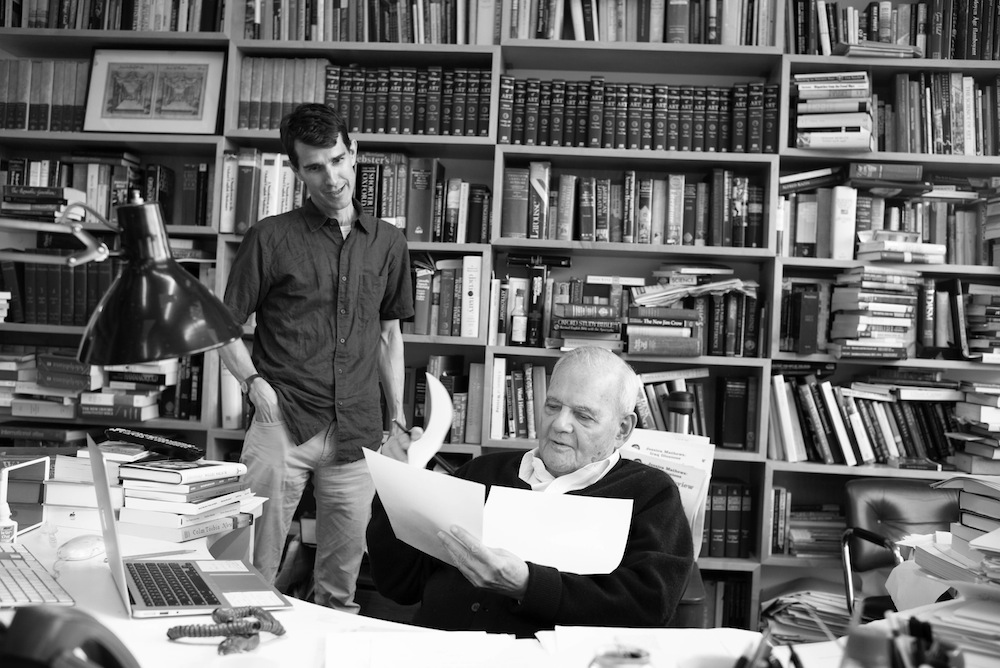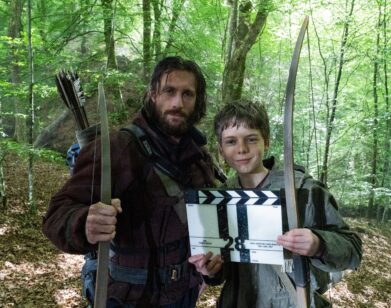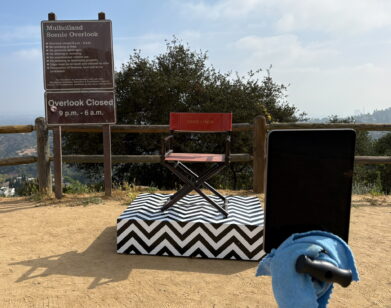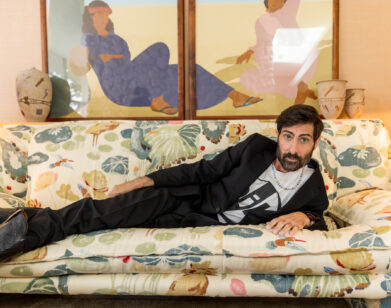What Robert Silvers Wants

HUGH EAKIN AND ROBERT SILVERS IN THE FIFTY YEAR ARGUMENT, PHOTO BY BRIGITTE LACOMBE/COURTESY OF HBO
Whether it likes it or not, since its inaugural publishing in 1963 The New York Review of Books has come to represent the highest echelon of the intellectual establishment. The current issue, on stands now, packs in a “Philosophy Special” alongside features on Coco Chanel, Southern Baptists in Texas, Kazimir Malevich, Israel, and William Burroughs. In the past, Hannah Arendt, Susan Sontag, Truman Capote, Joan Didion, Gore Vidal, and Norman Mailer have all contributed. Quality, imagination, and intellect are not just desirable for the Review; they’re the minimum requirement.
The biweekly paper has assumed an authority on political, cultural, and social matters, not just by commissioning the best brains to write for its pages, but by actively defining what it is, and what it is not. Co-edited by Robert Silvers, now 84, and Barbara Epstein until her death in 2006, the Review emerged out of the 1963 New York Times newspaper strike and was heavily influenced by Elizabeth Hardwick’s 1959 article in Harper‘s, “The Decline of Book Reviewing,” which took to task the various failings in vaunted literary journals. With the Review, Silvers and Epstein created a place where, yes, books were discussed, but where books and their subjects could act as an unfettered starting point for larger discourse, whether it was Mary McCarthy on the politics of the Vietnam War, Zadie Smith on The Social Network, or Jed Perl on Jeff Koons.
The Fifty Year Argument, a new documentary from HBO, takes on the Review on the occasion of its 50th anniversary. Co-directed by Martin Scorsese (a longtime reader) and David Tedeschi, the pair sourced archival footage, interviewed contributors past and present, and followed Silvers in the Review‘s book-cluttered office on Hudson Street.
Interview recently spoke to Silvers by phone. We were at our office in SoHo; Silvers was at his in the West Village.
COLLEEN KELSEY: When the Review turned 50 there was a lot of attention, but how specifically did this documentary come about?
ROBERT SILVERS: Well, we saw the 50th anniversary coming, and we thought we had a choice. We could simply go forward in the regular way, just putting out new issues, or we could try to do something about being 50. At that very time in the fall, a year ago more or less, a number of documentary filmmakers approached us. We talked to them; we saw their work. They were very impressive, some of them, but one thing that was clear was they didn’t know much about The New York Review. Someone here said, “Well, why not try Marty Scorsese?” I’d met his wife years ago. So I wrote him a note.
He immediately replied and said he was interested, that he was an old time reader of The Review since 1963 when he’d read it at NYU. He had piles of it around the house. He brought David Tedeschi, a director who’d worked with him on other documentaries. He’d made several including one on Bob Dylan, which is a brilliant film. They were faced with a difficult problem. We have published, say, 15,000 articles over these 50 years on practically every subject you can imagine: mathematics and Tibetan Buddhism, the politics of the Vietnam War. It is very difficult in a documentary to cover all of that, or most of it. But what they did was brilliant. They selected a number of themes, and went back into the archives of old film footage where you saw Mary McCarthy talking about going to Vietnam with The New York Review, you saw Norman Mailer arguing with Gore Vidal over a piece by Gore in The New York Review. They came up with footage that somehow had been left behind, you might say, in our past. They just kept on finding new things. I was amazed at it, that they were able to make such an interesting and coherent selection. I think it does represent a lot of the Review.
KELSEY: So it’s safe to say you trusted Marty’s vision?
SILVERS: I did, because I thought he understood it. I saw immediately that he and David Tedeschi had read it, and very closely. They were very intent, I thought, about covering a range of things. Some of it is done very subtly and quickly. There are many titles, and many covers, many passing shots of articles. That’s very much a suggestion of the range of the paper, and the writers of the paper, and the subjects of the paper.
KELSEY: When you first established the Review, there is that one editorial in the February 1, 1963 issue.
SILVERS: That’s the only editorial we’ve ever had.
KELSEY: Exactly. It details some of the intentions of what the Review set out to do. But in addition to that, were there any other provisions for what it was going to be, and what it wasn’t?
SILVERS: The crucial fact is that it was made possible because of that The New York Times strike. Jason Epstein saw that you could start a paper without a penny, because the publishers were going mad with no place to advertise. Therefore, they would all advertise if you had a plausible project. So we put together a layout with a number of names of people that we quickly had learned would be willing to contribute. That included people like Norman Mailer and Bill Styron and Gore Vidal and Edmund Wilson and W.H. Auden and Mary McCarthy and Robert Lowell and many others who were very well-known people, who we called immediately and asked to review a book within three weeks. There was no question of money. It was to start a new journal, and to show what a book review could be. Most of these advertising agencies and publishers did take a page, or part of a page. We were able to persuade a printer to put out the paper in three weeks. A great historian of mathematics, Jim Newman, contributed. So did Auden. So did Norman, and so on.
What we saw very quickly was two things. One, as long as we could support ourselves, by selling advertising and subscriptions, we could do anything we want. We owned the paper. We had no publisher, no foundation, no boss. Therefore we could do whatever interested us. We saw two other things. First, that there’s a book on nearly every subject. If we wanted to address nearly any subject, there would usually be a book to be reviewed. And in book reviewing, it’s very important to address the book, and its quality and its qualities. At the same time, it’s the subject that also deserves incisive treatment. If there’s a book on, let’s say, Buddhism, or on the persecution in Eastern Europe by the Soviet Union, the book itself had to be dealt with. But the subject is an enormous subject, and it requires someone with great ability, imagination, and a great, a marvelous, and a special capacity to make ideas clear. The book can be the occasion for the examination of subjects. These things all became clear to us doing these two original issues.
We saw, as we were reviewing these books, that enormous events were looming in front of us: the Civil Rights Movement, the Vietnam War, the Nixon administration. We felt that these were great waves of history coming at us and we had to deal with them. We dealt with them through books, but also by sending reporters, as when we sent Mary McCarthy to Vietnam or Joan Didion to El Salvador. Many other writers wrote either reports or book reviews that dealt with the huge events that were facing us. That’s what we have continued to do right now and our next issue will have several articles on Syria, for example.
KELSEY: This is something that I’m curious about—do you think that sending writers on certain assignments for the Review out of their typical subject matter or comfort zone has affected how some of these writers have approached their personal projects?
SILVERS: I think there was an element of adventure. For Joan, for example, to go to El Salvador, or to write about the Central Park Jogger, or to go to Miami where she wrote a brilliant piece on the whole conflict there between refugees and local people. She went to the Republican and Democratic conventions for us. She’s a novelist. She looked at these places with a novelist’s imagination, but also with a great reporter’s precision and observation.
KELSEY: The piece that Elizabeth Hardwick wrote, “The Decline of Book Reviewing” in Harper’s in 1959, the objections that she made, and points that she raised in that article, obviously spurred a lot of what the Review came to be.
SILVERS: She planted an idea there, that a book review, a literary journal, what we had wasn’t really what was needed, and that something else should come into existence.
KELSEY: But do you find that article to be continually relevant as the Review has gone on?
SILVERS: [laughs] I keep it in mind all the time, as a kind of warning. Lizzie in that article had a whole list of things that she thought should be avoided. Among them, “the light, little article,” and “the review with faint dissension.” I believe that article first harbored the warning of the dangers to a book review that’s worth the name. I must say, Lizzie was our advisory editor until she died, and she was, in the most marvelously, charming way, truly an advisory editor. [laughs] We would talk about an issue, and she would say things like [laughs], “Honey, you’ve got to do better than that.”
Barbara [Epstein] and I had what we thought was, and I think still is, a unique freedom. That, I feel, is one of the most central things about The Review, that we had the kind of freedom that I think hardly any editors have ever had, to do just what we wanted. If it wasn’t a book review, if it meant sending someone to China, whatever we thought was interesting, as long as we could pay the printer, we could go on. No one has interfered with us, no one has issued commands, no one has given orders. It’s just what we want.
KELSEY: How do you retain so much editorial autonomy whereas so many other publications are policed by advertisers or shareholders?
SILVERS: We started off owning it. We started off with that autonomy, and we only made an arrangement with Rea Hederman [the NYRB’s publisher since the ’80s], who has certainly improved the circulation, and the advertising, and everything about the distribution of the paper, not to mention inaugurating a whole, modern website, and a blog. Many of our regular contributors also contribute to the blog. But, the paper that we put out every two weeks, we put out in the same way of dealing with books, dealing with ideas, dealing with public events, governments, particularly with people who are in a situation where we are aware they’re being harassed, or bullied, or tortured, or killed, by government, and that obligation to take account of human rights, whether in this country or in communist countries, or in fascist countries or right-wing countries, or religiously dominated countries. That’s been a major theme of the Review since we started. For example, when the Eastern Europe was under communist control, we published 27 articles by Václav Havel. We published reports on Czechoslovakia and Poland by Timothy Garton Ash, who was a great expert on the communist regimes there. We published 10 articles by Andrei Sakharov from Russia when he was a dissident there. I think that in many places in the world, the Review became known as a place where kinds of suppression and persecution could be discussed.
KELSEY: Since there is so much freedom as to what a NYRB article can turn out to be, when working with a writer, how much control do you keep as an editor?
SILVERS: [laughs] Well, I’ll tell you, this is a very delicate question, because you have an article, and you can make suggestions. You may say, “Perhaps there is something that could get more discussion, or less discussion,” and, at a certain point, you may have to say, “Something is missing here. We can’t do it.” It’s a terrible thing for an editor because you’re asking people to take out a certain part of their lives, weeks, and do very difficult work reading a book intensely, taking notes, writing a review. It’s a huge responsibility to ask someone to do that. It’s horrible if you can’t use what they do. But the test of a paper, I think, is at a certain point, if you don’t feel a piece of writing is what it should be, and it doesn’t meet some basic standard, then you have to say no.
KELSEY: Where do you look for new or younger writers that you would like to include in the paper?
SILVERS: It’s a constant search. We depend so much on other people, on suggestions from our writers, about new writers they’re aware of. We’re constantly reading every kind of journal you can imagine to find new people. I feel that the lifeblood of a paper is precisely in that search, for new voices, for new writers, for new points-of-view. It’s one risk after another and that’s the essence. You have to take these risks.
THE FIFTY YEAR ARGUMENT IS NOW AVAILABLE TO WATCH ON HBO AND HBOGO.






